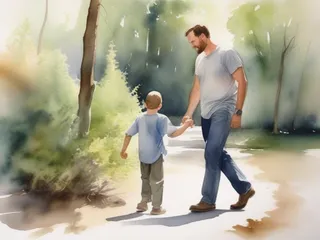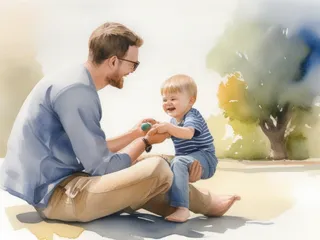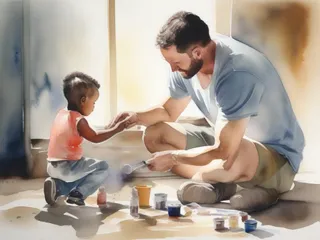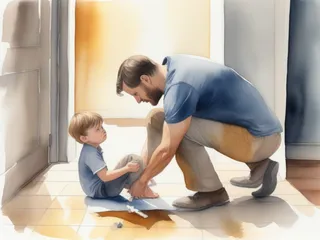Why gratitude isn't just feel-good fluff
Here's what I've learned about gratitude: it's not about forcing positivity or pretending everything is fine when it's not. It's about training your brain to notice what's working alongside what's broken. And in a world where our feeds are engineered to highlight everything that's wrong, that's become a survival skill.
As parents, we're competing against algorithms designed to capture attention through outrage and anxiety. Our kids are growing up in an environment where the default mode is dissatisfaction. Building a family culture of gratitude isn't about toxic positivity—it's about giving our kids tools to maintain perspective when the world feels overwhelming.
This isn't just warm and fuzzy parenting advice. The research on gratitude is solid: it measurably improves sleep, reduces anxiety, strengthens relationships, and builds resilience. More importantly, it's a skill that compounds over time. Kids who learn to notice and appreciate good things become adults who can weather challenges without losing hope.
The neuroscience behind gratitude
Your brain has a negativity bias—it's wired to notice threats and problems more readily than opportunities and successes. This kept our ancestors alive, but it makes modern life unnecessarily stressful. Gratitude practice literally rewires your neural pathways to balance this bias.
Think of it like refactoring your mental code. You're not deleting the error-checking functions (those are important), but you're adding better logic to recognize when things are running smoothly.
The compound benefits of family gratitude
When you practice gratitude consistently as a family, several things happen:
Enhanced emotional regulation Kids learn to shift their focus when they're stuck in negative thought loops. Instead of ruminating on what went wrong, they develop the habit of also noticing what went right.
Stronger family bonds Expressing appreciation for each other builds connection. When kids feel genuinely valued, they're more likely to contribute positively to family dynamics.
Increased resilience Families that regularly acknowledge good things build a reservoir of positive memories to draw from during tough times.
Better sleep and reduced anxiety Ending the day with gratitude shifts your nervous system from stress mode to rest mode. Kids who practice gratitude have fewer bedtime worries.
Moving beyond surface-level thankfulness
Most gratitude practices fail because they stay superficial. "I'm grateful for my family" becomes meaningless when repeated mechanically. Effective gratitude is specific, personal, and connected to real experiences.
The difference between appreciation and gratitude
Appreciation is noticing something good: "That sunset is beautiful." Gratitude includes the recognition of relationship: "I'm grateful we took the time to watch this sunset together."
Gratitude always includes connection—to people, experiences, or circumstances that contributed to something positive in your life.
Making gratitude specific and meaningful
Instead of generic thankfulness, help your kids develop specific appreciation:
-
Not: "I'm grateful for my teacher" * Better: "I'm grateful Ms. Johnson took extra time to explain fractions when I was confused"
-
Not: "I'm grateful for food" * Better: "I'm grateful Dad made my favorite pancakes on a school morning"
The specificity makes the gratitude real and reinforces the positive experience.
Practical gratitude strategies that actually work
Daily practices that stick
The three-good-things exercise Each day, everyone shares three specific things that went well and why they think each thing happened. The "why" component is crucial—it helps kids recognize their own agency and the role others play in positive experiences.
Gratitude texting Send your kids (or partner) specific texts about things you appreciate about them. "I noticed how patient you were with your little brother when he was being annoying. That showed real maturity."
The appreciation audit Once a week, do a family check-in where you specifically acknowledge each person's contributions. Make it concrete: "Your help with dishes this week meant I had time to read bedtime stories."
Gratitude in challenging moments
Reframe without dismissing When something difficult happens, don't jump straight to gratitude. Acknowledge the challenge first, then look for what's working alongside what's not.
"Today was really hard because you got that disappointing grade. And I'm grateful your teacher reached out immediately so we can make a plan to help."
The "and" practice Teach kids to hold both realities: "I'm frustrated about the rain ruining our picnic plans, AND I'm grateful we have a cozy house to hang out in."
This isn't about minimizing negative feelings—it's about not letting them eclipse everything else.
Making gratitude social
Appreciation bombing Occasionally surprise family members with specific appreciation. Leave notes in lunch boxes, send encouraging texts, or verbally acknowledge something they probably think went unnoticed.
Gratitude visits Help your kids write thank-you notes to people who've made a difference—teachers, coaches, friends' parents, grandparents. The act of articulating appreciation strengthens the neural pathways of gratitude.
Family service Volunteer together regularly. Nothing builds gratitude for what you have like helping others who have less. Make it age-appropriate and consistent rather than one-off charity work.
When gratitude feels forced or fake
Some days gratitude feels impossible. Your kid is melting down, work is stressful, and suggesting gratitude practice feels tone-deaf. That's normal.
Start microscopic
On hard days, go tiny:
- "I'm grateful this tantrum happened at home, not in the grocery store"
- "I'm grateful we have hot water for this shower"
- "I'm grateful my kid feels safe enough to express big emotions with me"
The goal isn't to feel overwhelmingly thankful—it's to maintain the practice even when it's difficult.
Model realistic gratitude
Let your kids see you practicing gratitude for ordinary things. "I'm grateful the coffee maker worked this morning because I really needed caffeine." This normalizes gratitude as something that includes small, daily experiences rather than just major events.
Building long-term gratitude habits
Age-appropriate practices
Younger kids (5-10)
- Bedtime gratitude sharing
- Drawing pictures of favorite parts of the day
- Thank-you note writing with help
- Gratitude scavenger hunts (find three beautiful things outside)
Tweens and teens (11+)
- Gratitude journaling with specific prompts
- Photography projects capturing daily appreciation
- Volunteer work that connects to their interests
- Expressing appreciation to friends and teachers independently
Technology integration
Use technology intentionally to support gratitude:
- Family photo albums highlighting positive memories
- Voice recordings of gratitude shares when family members are traveling
- Apps that prompt daily gratitude reflection (but keep it simple)
Avoiding gratitude burnout
Don't make every conversation about gratitude. It should feel natural, not forced. Some days you'll skip it, and that's fine. Consistency matters more than perfection.
The ripple effect
Kids who grow up in families that practice genuine gratitude become adults who can find meaning in ordinary moments, maintain hope during difficult seasons, and build strong relationships based on appreciation rather than criticism.
They also become people who contribute positively to their communities because they understand their interconnectedness with others.
TL;DR: Your gratitude implementation plan
-
Start specific: Focus on concrete experiences rather than general thankfulness
-
Make it routine: Build gratitude into existing family rhythms (meals, bedtime, car rides)
-
Model authentically: Let kids see you practicing gratitude for ordinary things
-
Include challenges: Teach kids to hold both difficult and positive realities simultaneously
-
Connect socially: Regular appreciation of family members and thank-you notes to others
-
Keep it age-appropriate: Adjust practices as kids develop cognitively and emotionally
-
Stay consistent, not perfect: Miss days without guilt, but maintain the overall practice
Gratitude isn't about pretending everything is wonderful. It's about building your family's capacity to notice and appreciate what's working while you're also dealing with what's not. In a world designed to highlight problems, that's a radical act of resistance—and a gift you can give your kids that will serve them for life.





